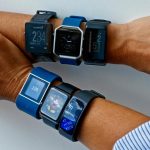 Wearable technology is increasingly capable of providing an early warning system for a range of diseases. For instance, smart bandages are increasingly able to detect infection significantly sooner than would otherwise be the case.
Wearable technology is increasingly capable of providing an early warning system for a range of diseases. For instance, smart bandages are increasingly able to detect infection significantly sooner than would otherwise be the case.
Smartphones have become increasingly capable of performing a range of monitoring and detection services in recent years, whether it’s checking our eyes and ears or even scanning for cancer. A University of Washington project even utilized the device for anemia detection.
A recent Stanford based study highlights the range of possibilities with this method of illness detection. They tracked 60 people equipped with smart watches and other biosensor devices as they went about their daily lives. It reveals that it is increasingly possible to flag when people have regular illnesses such as colds, but even early signs of more complex conditions, such as diabetes.
Smarter healthcare
We already use such devices for various fitness tracking purposes, but rarely are they used to keep an eye out for illness. The average smartphone is capable of many things however, most of which are untapped today. The researchers capitalized on this rich capability set to collect a range of measurements from the participants over a two year period. The aim was to define a baseline for each metric, and then detect variations from that.
Many diseases change things like our heart rate and temperature, and with smartphones constantly measuring these things, they provide an almost constant stream of data to work with. The team wrote some software to spot these deviations, and were subsequently able to detect a range of illnesses, from the common cold to Lyme disease.
The authors hope that their work will pave the way for smartphones to become crucial tools in us understanding, and maintaining good health.
In addition to spotting illness, the authors found that several people discovered insulin resistance, which places them at high risk of Type 2 diabetes, that they were not previously aware of. The researchers believe that it would be relatively simple to develop biosensors to perform a straightforward test for Type 2 diabetes from variations in heart rate patterns.
Integrating with clinical data
Of course, a major challenge is integrating the data generated by our smartphones with the plethora of other medical data about us, whether it’s your patient record, your mobile apps or even your genome. It’s a topic I’ve touched on a few times, not least with the recent publication by the European Commission around big data in healthcare.
“The information collected could aid your physician, although we can expect some initial challenges in how to integrate the data into clinical practice,” the Stanford team say. “Physicians and third-party payers will demand robust research to help guide how this comprehensive longitudinal personal data should be used in clinical care,” Snyder said. “However, in the long-term I am very optimistic that personal biosensors will help us maintain healthier lives.”